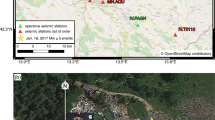Abstract
Snow avalanche is one of the life-claiming disasters in the snow-covered mountain regions of the world. It is an event which occurs when a top layer of snow loses its strength by the breakage of bonds with the bottom layers. This rupture results in a sudden release of elastic energy, which causes the emission of acoustic signals. Seismic geophones deployed near the avalanche-prone regions automatically detect these acoustic signals whose response represents the magnitude of triggered avalanches. The data on avalanche activity is vital for avalanche forecasting in order to alert people of certain regions in advance to reduce harmful effects of avalanches. To be helpful in avalanche forecasting, we have developed a utility with the help of MATLAB GUIDE resource to investigate snow avalanche data recorded on different days. The utility includes various segments for avalanche data processing, using which the seismic activity can be precisely classified. By analyzing various spectral parameters of the avalanche activity, our module could provide accurate information on the impact of triggered avalanches. Eventually, we also compared avalanche data with other background activities like earthquake signals, explosion noise and aeroplane noise in order to minimize the possibility of false-alarming.








Similar content being viewed by others
References
Baggi S and Schweizer J 2009 Characteristics of wet snow avalanche activity: 20 years of observations from a high alpine valley (Dischma, Switzerland); Nat. Hazards 50 97–108, https://doi.org/10.1007/s11069-008-9322-7.
Biescas B, Dufour F, Furdada G, Khazaradze G and Surinach E 2003 Frequency content evolution of snow avalanche seismic signals; Surv. Geophys. 24(5) 447–464.
Chadha A, Chadha A and Satam N 2017 Snow avalanche: Study and detection using remote sensing techniques; Int. J. Recent Trends Eng. Res. 3(4) 11–23, https://doi.org/10.23883/ijrter.2017.3097.ynyr8.
Kogelnig A 2012 Development of acoustic monitoring for alpine mass movements; PhD Thesis, Institute of Mountain Risk Engineering, University of Natural Resources and Life Sciences, Vienna, Austria.
Koschuch R, Jocham P and Hübl J 2015 One year use of high-frequency RADAR technology in alpine mass movement monitoring: Principles and performance for torrential activities; Eng. Geol. Soc. Terr. 3(14) 69–72, https://doi.org/10.1007/978-3-319-09054-2_14.
Marchetti E, Ripepe M, Ulivieri G and Kogelnig A 2015 Infrasound array criteria for automatic detection and front velocity estimation of snow avalanches towards a real-time early-warning system; Nat. Hazards Earth Syst. Sci. 15 2545–2555, https://doi.org/10.5194/nhess-15-2545-2015.
Prokop A, Wirbel A and Jungmayr M 2013 The "Avalanche Detector", a new avalanche monitoring tool using distributed acoustic fibre optic sensing; International Snow Science Workshop ISSW, Grenoble – Chamonix Mont-Blanc, France, pp. 1027–1032.
Prokop A, Schön P, Wirbel A and Jungmayr M 2014 Monitoring avalanche activity using distributed acoustic fiber optic sensing; Proceedings, International Snow Science Workshop ISSW, Banff, Canada, pp. 129–133.
Provost F, Malet J P, Hibert C, Helmstetter A, Radiguet M, Amitrano D, Langet N, Larose E, Abancó C, Hürlimann M, Lebourg T, Levy C, Roy G L, Ulrich P, Vidal M and Vial B 2018 Towards a standard typology of endogenous landslide seismic sources; Earth Surf. Dyn. 6 1059–1088, https://doi.org/10.5194/esurf-6-1059-2018.
Schimmel A, Hubl J, Koschuch R and Reiweger I 2017 Automatic detection of avalanches: Evaluation of three different approaches; Nat. Hazards 87 83–102, https://doi.org/10.1007/s11069-017-2754-1.
Schweizer J, Jamieson J B and Schneebeli M 2003a Snow avalanche formation; Rev. Geophys. 41(4) 1016, https://doi.org/10.1029/2002RG000123.
Schweizer J, Kronholm K and Wiesinger T 2003b Verification of regional snowpack stability and avalanche danger; Cold Reg. Sci. Technol. 37(3) 277–288.
Srinivasan K, Ganju A and Sharma S S 2005 Usefulness of mesoscale weather forecast for avalanche forecasting; Curr. Sci. (Special Section: Mountain Weather Forecasting) 88(6) 921–926.
Valt M and Pesaresi D 2009 Detecting snow avalanches with seismic stations in North-east Italy: first results of dataset analysis; Proceedings, International Snow Science Workshop ISSW, Davos, Switzerland, pp. 458–462.
Van Herwijnen A and Schweizer J 2011a Seismic sensor array for monitoring an avalanche start zone: Design, deployment and preliminary results; J. Glaciol. 57(202) 267–276, https://doi.org/10.3189/002214311796405933.
Van Herwijnen A and Schweizer J 2011b Monitoring avalanche activity using a seismic sensor; Cold Reg. Sci. Technol. 69 165–176, https://doi.org/10.1016/j.coldregions.2011.06.008.
Van Herwijnen A, Turner J and Schweizer J 2010 Listening to snow-avalanche detection using a seismic sensor array; International Snow Science Workshop ISSW, CA, USA, pp. 373–379.
Acknowledgements
The authors would like to thank Dr J C Kapil, Scientist – E at the Snow and Avalanche Study Establishment (SASE) – Chandigarh of the Defence Research and Development Organization (DRDO), for their guidance and providing the vital real-time seismic data.
Author information
Authors and Affiliations
Contributions
S S S D Koushik: Conceptualization, modelling, development, simulation, result analysis, and preparation of the draft of the manuscript. Ashavani Kumar: Guidance, review and valuable supervision. J C Kapil: Guidance, conceptualization, modelling, result analysis, review and valuable supervision.
Corresponding author
Additional information
Communicated by Somnath Dasgupta
Corresponding editor: Somnath Dasgupta
Rights and permissions
Springer Nature or its licensor (e.g. a society or other partner) holds exclusive rights to this article under a publishing agreement with the author(s) or other rightsholder(s); author self-archiving of the accepted manuscript version of this article is solely governed by the terms of such publishing agreement and applicable law.
About this article
Cite this article
Koushik, S.S.S.D., Kumar, A. & Kapil, J.C. Development of seismic signal-based snow-avalanche spectral utility. J Earth Syst Sci 133, 25 (2024). https://doi.org/10.1007/s12040-023-02236-5
Received:
Revised:
Accepted:
Published:
DOI: https://doi.org/10.1007/s12040-023-02236-5




